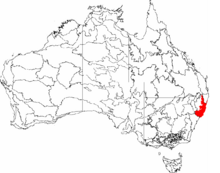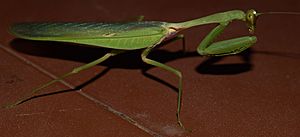Djangadi facts for kids
Quick facts for kids Dunghutti people |
|
|---|---|
| aka: Dhangadi, Boorkutti, Burgadi, Burugardi, Dainggati, Dainiguid, Dang-getti, Dangadi, Dangati, Danggadi, Danghetti, Dhangatty, Djaingadi, Nulla Nulla, Tang-gette, Tangetti, and Thangatti | |

NSW North Coast bioregion
|
|
| Hierarchy | |
| Language family: | Pama–Nyungan |
| Language branch: | Yuin–Kuric |
| Language group: | Yora |
| Group dialects: | Dunghutti |
| Area | |
| Location: | Mid North Coast, New South Wales |
| Rivers | |
| Urban areas | |
The Dunghutti people (also known as Djangadi, Dhungatti, Dainggati, or Tunggutti) are an Aboriginal Australian group. They live in the Macleay Valley area of northern New South Wales, Australia. Their history and culture are deeply connected to this land.
Contents
Dunghutti Language
The Dhanggati / Dunghutti language is part of the Yuin–Kuric language family. It is often grouped with the Anēwan language. Today, the Ngabu Bingayi Aboriginal Corporation helps teach and bring back the Dunghutti language in the Macleay Valley. A linguist named Amanda Lissarrague has helped a lot with these efforts. You can even learn the language at Kempsey TAFE.
Dunghutti Country
The traditional lands of the Dunghutti people covered about 3,500 square miles (9,065 square kilometers). This area stretched from Point Lookout south to the start of the Macleay River. It also included the area near the Mount Royal Range. To the east, their land reached the coastal mountains. To the west, it went up to the Great Dividing Range and Walcha. The Gumbaynggirr people lived to their north. The Anēwan people were to their west. The Biripi people lived to their south.
Dunghutti People and Culture
The Dunghutti people have a rich culture.
- Nulla Nulla
- Conderang.
Totems are important in Dunghutti culture. They can be for a whole group or for a single person. For example, the praying mantis (called gurginj gurginj) is a river totem. It represents the river from Bellbrook down to Georges Creek. Animals like the echidna can be personal totems. This means a specific person is connected to that animal. A group of related families was called a dawun.
Sacred Sites
The Dunghutti people have special stories about how the land was created. One story tells of the Rainbow Serpent. It is believed to have created the gorge at Apsley Falls during the Dreamtime. The story says it went underground and then came out again at a place called the mill hole near Walcha on the Apsley River.
Burrel Bulai
Burrel Bulai, also known as Mount Anderson, is a very important sacred site in Dunghutti Country. It was officially recognized as a significant place.
Long Gully
This site has two high ridges overlooking it. It was used for important ceremonies, like the final stages of initiation for young men, as late as 1932.
Carrai Waterholes
Young Dunghutti men would go through special initiation rites at the Carrai Waterholes.
Dunghutti History
Evidence shows that Aboriginal people have lived in the Dunghutti lands for at least 4,000 years. This was found by studying old sites like the Clybucca midden. These sites have ancient campsites with shell mounds up to 2 meters high. Other signs of ancient life include fish traps and a bora ring near Crescent Head.
European people started coming into Dunghutti lands in the late 1820s. These were mostly former convicts who came to cut cedar trees. By 1835, the first European settler, Enoch William Rudder, bought land in the Kempsey area. Within ten years, most of the valuable cedar trees were cut down. This made the land good for farming and raising animals. By 1847, many farms were set up along the Macleay River.
This time also saw difficult conflicts in the Macleay gorges. It is believed that many Dunghutti people were lost during these conflicts. The Dunghutti and other local groups used clever tactics to protect their land. They would attack shepherds and raid farms, taking sheep and cattle. Then they would retreat into the gorges, where it was hard for others to follow. For example, in 1840, many people were killed at Kunderang Brook. These conflicts ended around 1851 when a special police force was set up. By then, the number of Aboriginal people in the area had greatly reduced.
Some Dunghutti people settled on islands in the Macleay River, like Shark, Pelican, and Fattorini Islands. These were made into special Aboriginal reserves in 1885. They grew corn there. Later, in 1924, people from Fattorini Island moved to Pelican Island. Eventually, many Dunghutti people moved to Kinchela Creek Station. However, some stayed at an unofficial camp at Green Hills. In 1947, Aboriginal children were finally allowed to attend Green Hill Public School.
Native Title
The Dunghutti people were the first on mainland Australia to successfully claim native title rights to their land. The New South Wales Government recognized their rights in the Crescent Head Agreement. They received money as compensation. Later, they received more money for 12.4 hectares of land at Crescent Head that was planned for housing.
Dunghutti Culture Today
The Wigay Aboriginal Cultural Park near Kempsey is a great place to learn about Dunghutti culture. It has over 150 different native plants from the Macleay Valley. The park shows different types of plants found in rainforests, dry forests, and wetlands.
Notable Dunghutti People
Boxers
- Bradley Hore
- Renold Quinlan - Middleweight champion
- Dave Sands
- Hector Thompson
Rugby League Players
Other Notable Dunghutti People
- Torita Blake, Paralympian athlete
- Blak Douglas, winner of the 2022 Archibald Prize
- Samantha Harris, fashion model
- Loretta Kelly, law academic
- Amos Morris, guitarist


